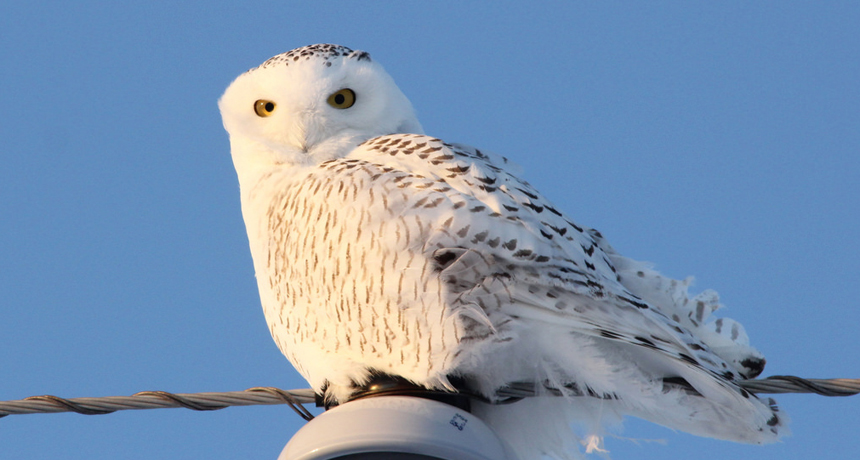We’re only noticing the snowy owls
A lemming boom last summer probably led to rises in populations of several predator species

Snowy owls usually confine themselves to the Arctic, but many have been traveling much farther south this winter. This bird was photographed in Wisconsin this month.
Jerry Davis, Wisconsin Department of Natural Resources/Flickr
- More than 2 years ago
Residents of many of the Lower 48 states have been entranced this winter by visitors from the Arctic — snowy owls. The birds haven’t all found their winter vacations to be that wonderful, though: DC’s snowy owl survived being hit by a bus but Philly’s bird was killed by an airplane. The record-breaking influx of birds that are normally rare this far south can probably be traced to a bumper crop of lemmings last summer, scientists think. Lots of lemmings let mama and papa snowy owls provide for lots of baby owls, and many of those owls, for unknown reasons, have decided to fly south for the winter.
Lemmings and snowy owls are part of a well-documented four-year cycle of prey and predator populations. Peaks in lemming numbers feed a boom in snowy owls. All those snowy owls force the lemming numbers back down. With fewer lemmings around the next year, snowy owl numbers start to fall. Fewer owls means that the lemming numbers can start to rise again, and the cycle starts over again.
That would be a classic predator-prey cycle. But on the Arctic tundra, it’s actually more complicated because snowy owls aren’t the only predators that feast on lemmings. One study, published in Arctic in 1950, noted that a 1949 boom in brown lemmings in Point Barrow, Alaska, came along with increases in the population of snowy owls, Arctic foxes and seabirds called jaegers (also known as skuas). The paper noted that the four-year cycle was at work in this area of Alaska, though perhaps not for the collared lemming. It also said that native Alaskans had recognized the correlation of lemming booms with those of other animals.
A 1963 study published in Science described a lemming cycle in Baker Lake, Canada. Its author, however, was perplexed by the four-year period of lemming population ups and downs. He observed a rise in the number of weasels — another lemming predator — after the lemmings had started their decline, but he didn’t connect the weasel numbers with the lemming boom.
Similar lemming cycles have been seen in their European habitats, and the best-documented might be one from Greenland, which was described in 2003 in Science. A team of ecologists working in the Karup Valley of northeast Greenland studied the densities, breeding success and diets of collared lemmings and four lemming predators — snowy owls, weasels, arctic foxes and long-tailed skuas — from 1998 to 2002 and also looked at historical records for the animals. The lemming numbers followed the regular four-year cycle, with their peaks followed a year later by peaks in the population of weasels. The owls, skuas and foxes also did well following peak lemming years.
But not all the predators had the same effect on the lemming numbers, the researchers discovered when they created a computer simulation of the predator and prey populations. When the researchers removed weasels from the simulation, the regular cycling of lemmings disappeared. The other three predators weren’t enough to keep the lemmings in check and proved important only for stabilizing the cycle.
Far south in the Lower 48, the only part of this cycle that people are ever likely to see is the rare snowy owl that decides to escape the boom up north. Lemmings, weasels, foxes and seabirds either can’t travel this far, don’t bother doing so or we just don’t notice them as much as the striking owls. But up in the Arctic, residents should look around this winter for other lemming predators, since they also probably benefited from last summer’s peak lemming numbers. Or we can all wait another four years to watch it happen again.






